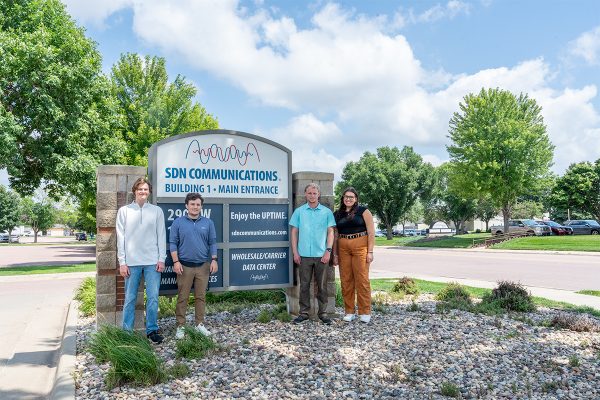The vast majority of wireless phone calls made in South Dakota travel at least part of their journey on fiber owned by SDN Communications.
SDN lines typically carry wireless calls from the nearest cell tower to the phone service’s switching station.
Providing scalable, wireless backhaul, or fiber to the tower, represents a significant part of Sioux Falls-based SDN’s wholesale services, which also include providing broadband infrastructure to help carriers transport data for their clients.
With an increasing amount of electronic information moving from mobile devices and on the Internet, wholesale services are a growing part of SDN’s business.
“Everybody wants more bandwidth to transfer their data,” says Wholesale Carrier Relations Executive Ryan Punt.
Punt and JJ Anderson, who is also a wholesale carrier relations executive, are SDN’s point men on the wholesale sales front. They are veterans of the telecommunications industry. Anderson has been with SDN for more than 11 years, and Punt has been with the company for nearly nine years.
“What takes up most of our time is backhaul for wireless carriers,” Anderson says.
Anderson and Punt work with Dan Eich, a sales engineer, and with two sales support staff members to serve SDN’s wholesale customers. Most of their client companies are based in other states.
SDN’s reach is constantly expanding as more carriers tie into the company’s regional network. The SDN’s South Dakota-based network ties into several other systems in eight other states in the region.
SDN offers alternate routes
SDN has 10 connecting sites, called carrier hotels or Point of Presence locations (select the map to see a larger version). The Points of Presence, or POP locations, are facilities where carriers have the equipment and can connect with other networks to expand their reach.
SDN has two POP locations in Sioux Falls. One is on its main campus in west-central Sioux Falls. The other is in the SDN Communications Data Center in the northwest corner of the city. The other eight POP sites are in cities in other states in Upper Great Plains. The cities are:
- Minneapolis, Minn.
- Omaha, Neb.
- Denver, Colo.
- Chicago, Ill.
- Fargo, N.D.
- Sioux City, Iowa
- Caspar, Wyo.
- Bellevue, Neb.
SDN’s regional network includes transportation lines owned by SDN and its affiliates as well as leased lines. The network crosses South Dakota and reaches into Minnesota, Iowa, Nebraska, North Dakota, Wyoming, Montana, Colorado, and Illinois.
SDN can provide carriers with alternate routes to communities in the southern part of the network. For example, instead of going from Omaha to Des Moines, Iowa to Minneapolis, information can be sent from Omaha to Sioux Falls to Minneapolis. Or information going from Denver to Minneapolis can go through Caspar and South Dakota instead of Nebraska and Iowa.
In addition to its 10 major POP locations in the region, SDN has more than a dozen smaller, metro POP locations in cities such as Rapid City and Pierre, S.D., and Marshall and Worthington, Minn.
POPs help clients optimize their networks by providing connections to the rest of the world with a minimum of time delay, or latency.
In addition, SDN is part of Indatel, a team of independent telecom carriers that can help simplify the connection process across the nation.
SDN will help wholesale customers develop custom network solutions and install fiber where their clients need it.
Staffers in SDN’s Network Operations Center monitor the company’s system and provide live support 24 hours a day, every day of the year.
SDN’s network can accommodate a variety of transmission methods and provide a variety of protection and speed options.



